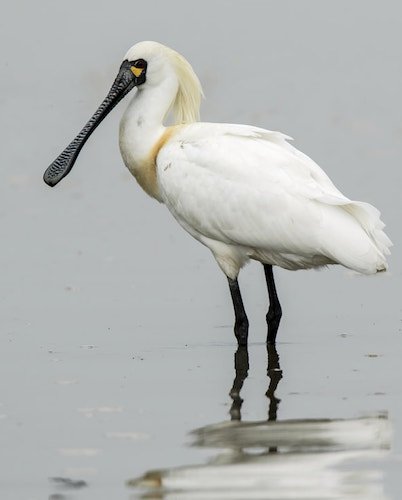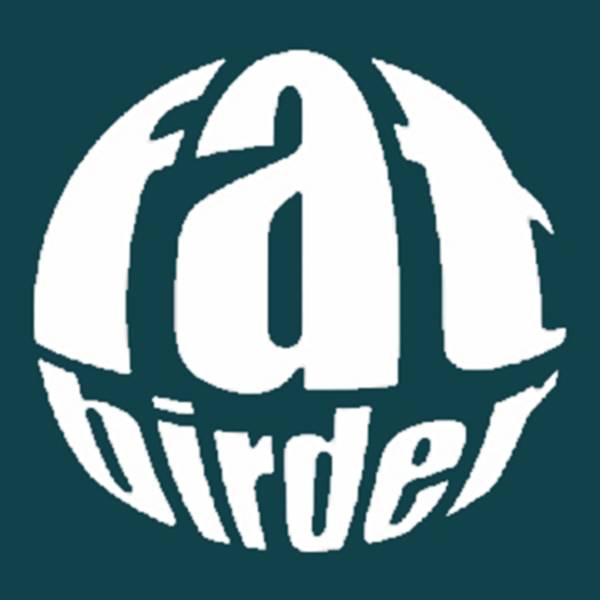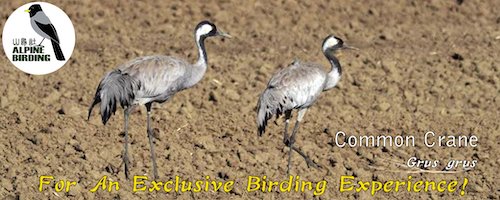Hong Kong Special Administrative Region

Birding Hong Kong
The Special Administrative Region of Hong Kong lies on the southern coast of China close to the Tropic of Cancer. Its 1,070 sq kilometres are divided into four main areas – Hong Kong Island, Kowloon, the New Territories and the Outlying Islands. Hong Kong’s tropical climate, typified by the unpleasantly hot and humid summer months with the occasional typhoon thrown in for good measure, is influenced by the continental landmass to the north so that temperatures can occasionally fall as low as 5ºC in winter. Autumn is the most pleasant time of the year weather-wise, being usually relatively dry and clear, whereas spring can be unsettled – and from an ornithological perspective, the more unsettled the weather at this time of year, the better the bird watching tends to be.Hong Kong’s image as an intensely urbanised area is an accurate one yet roughly 40% of the territory is made up of country parks or special reserves, some of which contain excellent forest areas. The best of these is Tai Po Kau, an easily accessible reserve that offers excellent woodland birding. Sadly, however, many of the ecologically important sites in the territory are not found within the country park boundaries and the northern New Territories in particular, with its low-lying areas of fish ponds, vegetable farms and marshes, is earmarked for intensive development over the next few years. Fortunately the marshes and mudflats in the Deep Bay area, centred on the internationally renowned nature reserve at Mai Po, have been declared a Ramsar site and it is this area that is the main ornithological focus in the region.Over 480 species of birds have been recorded in the territory. The vast majority of these are passage migrants and/or winter visitors and the best time to visit is from September to early May. Although Hong Kong lies within the Oriental region, it is perhaps most famous for the large numbers of eastern Palaearctic waders that occur on passage, especially in April, which is the main month for overseas birdwatchers to visit in search of such species as Spoon-billed Sandpiper, Asian Dowitcher and Nordmann’s Greenshank. The territory regularly attracts other Palaearctic species that are major rarities in Britain and North America. In fact approximately 80 species described in A Field Guide to the Rare Birds of Britain and Europe (Lewington, Alström and Colston 1991) occur here.Most accommodation is located on Hong Kong Island and in Kowloon. Although visiting birdwatchers will spend most of their time in the New Territories, this is no problem as the transport system is very efficient and access to the main birding sites is easy. For those wishing to be closer to the birding sites, there are two good hotels in Sha Tin in the southern New Territories and less luxurious, but perfectly adequate accommodation is available at Mai Po itself [Book in Advance].Immediately to the north of the Hong Kong Semi-Autonomous Region is Guangdong Province. A number of sites in the province are accessible from Hong Kong provided the birdwatcher has a few days to spare. The best of these are Ba Bao Shan and Chebaling, both in the north of the province and both a day’s combined train ride and bus journey from Shenzhen, the Chinese city just over the border from Hong Kong. These sites have a number of enigmatic Oriental species not found in Hong Kong e.g. Cabot’s Tragopan and Silver Oriole (summer) at Ba Bao Shan, Blyth’s Kingfisher and the (very rare) White-eared Night Heron at Chebaling. These and other sites in Guangdong, as well as the main sites in Hong Kong, are detailed in Where to Watch Birds and Other Wildlife in Hong Kong and Guangdong (Woodward and Carey, 1996). Birds of Hong Kong and South China (Viney and Phillipps, 1994) remains the essential field guide to the region. A new, very detailed account of the birds of Hong Kong, The Avifauna of Hong Kong (Carey et. al) is due out in the latter half of the year 2000.
-
Number of bird species: 530
(As at August 2018)
-
iGoTerra Checklist
iGoTerra ChecklistFatbirder Associate iGoTerra offers the most comprehensive and up to date birds lists on the web
-
A Field Guide to the Birds of China
| By John MacKinnon, Karen Phillipps & Dave Showler | Oxford University Press | 2000 | Paperback | 586 pages, 128 colour plates, colour maps | ISBN: 9780198549406 Buy this book from NHBS.com -
A Naturalist's Guide to the Birds of Hong Kong
| By Ray Tipper | John Beaufoy Books | 2016 | Paperback | 176 pages, ~300 colour photos, 2 colour maps | ISBN: 9781909612082 Buy this book from NHBS.com -
A Photographic Guide to the Birds of Hong Kong
| Edited by Chan Kai Tai & Sophie Fan | Hong Kong Birdwatching Society | 2004 | Paperback | 559 pages, 760+ colour photos, b/w illustrations | ISBN: 9783621428941 Buy this book from NHBS.com -
Birding South East China
| By Tim J Woodward | Tim Woodward | 2006 Paperback | 423 pages, 88 colour photos, 160 maps | ISBN: 9789628508426 Buy this book from NHBS.com -
Birds of East Asia
| (Eastern China, Taiwan, Korea, Japan, Eastern Russia) | by Mark Brazil | Christopher Helm | 2009 | Paperback | 528 pages, 234 colour plates, colour distribution maps, b/w illustrations | ISBN: 9780713670400 Buy this book from NHBS.com -
Birds of Hong Kong
| Ray Tipper | John Beaufoy Publishing | 2021 | Paperback | 176 Pages | 300 colour photos, 2 colour maps | £12.99p ISBN: 9781913679088 Buy this book from NHBS.com -
The Avifauna of Hong Kong
| By GJ Carey, ML Chalmers, DA Diskin & PJ Kennerley | Hong Kong Bird Watching Society | 2001 | Hardback | 563 pages, 31 colour plates, 412 figures, 20 tables, 139 maps | ISBN: 9789627508021 Buy this book from NHBS.com -
The Birds of Hong Kong and South China
| By Clive Viney, Karen Phillips & Lam Chiu Ying | Hong Kong Government Information Service | 2005 | Paperback | 255 pages, 91 colour plates, b/w illustrations, 4 maps | ISBN: 9789620204043 Buy this book from NHBS.com -
Where to Watch Birds and Other Wildlife in Hong Kong and Guangdong
| By Tim J Woodward & Geoff J Carey | Tim Woodward | 1996 | Paperback | 197 pages, colour photos, line illustrations, 30 maps | ISBN: 9789628508419 Buy this book from NHBS.com

Common Birds of Hong Kong
AndroidThe first cross-platform bird information app in Hong Kong that allows you to access multimedia information of common birds of Hong Kong for free.Organisations-
Hong Kong Birdwatching Society
WebsiteRoom 625, Beverley Commercial Building, 87-105 Chatham Road, Tsim Sha Tsui, Kowloon. + 852 2377 4387 hkbws@hkbws.org.hk Hong Kong is an excellent place to watch birds. It is famous for the large numbers of Eastern Palearctic waders that occur on passage, and the territory regularly attracts other species that are major rarities in Britain or North America. The HKBWS was founded in 1957, and is now an active and fast-growing society with a membership of around 400 from Hong Kong and overseas. It publishes a quarterly bulletin and an annual Bird Report. The society runs regular field outings in Hong Kong throughout the year, led by experienced locals and all members are welcome to join. Sometimes groups from the Society visit the People`s Republic of China and other places in the region on bird watching trips. Members participate in waterfowl counts throughout the year. The Society has also set up a project fund, through the funding, another hide off Mai Po boardwalk has built in 1996. The fund has also support updating work of the Annoated Checklist in Hong Kong and the set up of HKBWS China Conservation Fund. -
World Wide Fund for Nature Hong Kong
WebsiteAs a haven for thousands of migratory waterbirds every year, Mai Po Nature Reserve and the surrounding Inner Deep Bay wetlands sets a prime example of conservation success for regional wetlands, and offers visitors a chance to get up close to wildlife and appreciate the beauty of nature.
Reserves-
NR & WII Mai Po
WebsiteSatellite ViewLocated on the northwestern corner of Hong Kong, the Mai Po and Inner Deep Bay wetlands is recognized as 'Wetland of International Importance' under the prestigious Ramsar Convention in 1995. The 1,500-hectare area acts as a key way station and wintering site along the East Asian-Australasian Flyway where 50 million migratory waterbirds travel through each year... -
NR Tai Po Kau
InformationSatellite ViewThe Tai Po Kau Nature Reserve, also called Tai Po Kau Special Area, is a nature reserve in the Tai Po area of the New Territories in northern Hong Kong. The area comprises a dense, hilly woodland with countless species of trees and numerous streams and rivers. It is noted by the Hong Kong Bird Watching Society and others as one of the best locations for seeing forest birds in Hong Kong.
Guides & Tour Operators-
Birding Hong Kong
Tour OperatorFor those birders passing through Hong Kong who might like the services of a professional local guide, please feel free to contact me. In the last five years, I have taken many birdwatchers out to Mai Po, Tai Po Kau and Long Valley - as well as other good sites - and cater to all levels of experience and interest.
Trip Reports-
2012 [March] - Paul Davis
Report...I spotted Masked Laughing Thrushes, Blue Whistling Thrush, Oriental Magpie Robins, Lemon-crested Cockatoos, Spotted Doves, Black-crowned Night Herons, Red-whiskered Bulbuls, Chinese Bulbuls, Black-collared Starlings and Common Tailorbirds on every visit. There are also large groups of Eurasian Tree Sparrows looking for a friendly visitor to feed them and the ever present Black Kites are circling above... -
2017 [04 April] - Paul Sharp
PDF Report...Black-faced Spoonbillswere still present, though mostly roosting (so far only 3 had been seen in flight), a couple of Whiskered Ternslurked amidst the larger Caspianand Gull-billed Ternsand Black-headed Gulls, a few Broad-billed Sandpipersscurried about in with the many Red-necked Stints, and a Little Stint, pointed out by another friendly birder in the hide, who also gave some helpful tips on separating the Lesserand Greater Sandploverspresen...
Other Links-
Bird Names in Chinese, Japanese, and Vietnamese
WebsiteWhat's so great about a list of bird names? After all, the names that men give can never be more than just a pale reflection of the birds themselves. Well, bird-lovers may rejoice in bio-diversity, but in matters linguistic they tend to use common or garden English as a lowest common denominator. So, in the interest of lingua-diversity, here it is: the site where you`ll find hundreds of bird names in three East Asian languages. Happy birdwatching! Note: The scope of this site is limited to birds found in China (incl. Hongkong, Macau, and Taiwan); Japan, and Vietnam. As the site is still in development, information may be inaccurate or incomplete; any comments or corrections would be appreciated. -
Birding Hong Kong
WebsiteWelcome to Birding Hong Kong, a website about all things to do with birds and birding in the Hong Kong SAR. In the following pages, you will find details of latest sightings in the territory; information about the best sites to go birding; images of some of the bird you are likely to encounter and much more... -
Hong Kong Birdwatching
WebsiteLying in the tropics, on migration routes for birds breeding from Japan west to Russia and north China, and boasting a range of habitats including the world-renowned Mai Po Marshes Nature Reserve, Hong Kong is an excellent place for birdwatching. Here, you can find global rarities that are tough to see elsewhere, encounter stunning songbirds, watch seabirds blasted inshore by typhoons (yes, typhoons
Blogs-
Fatbirder - linking birders worldwide... Wildlife Travellers see our sister site: WAND
Skip to content

